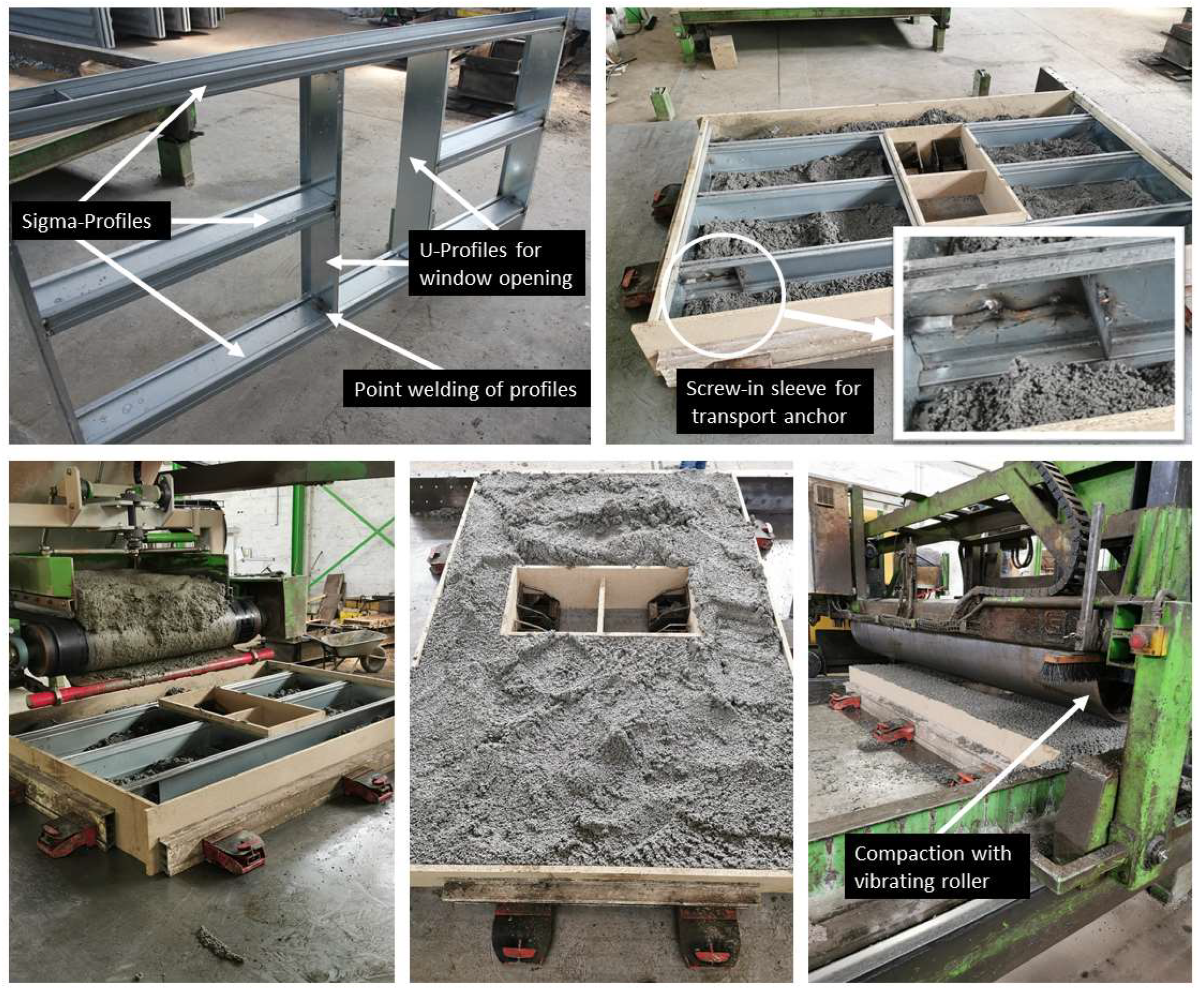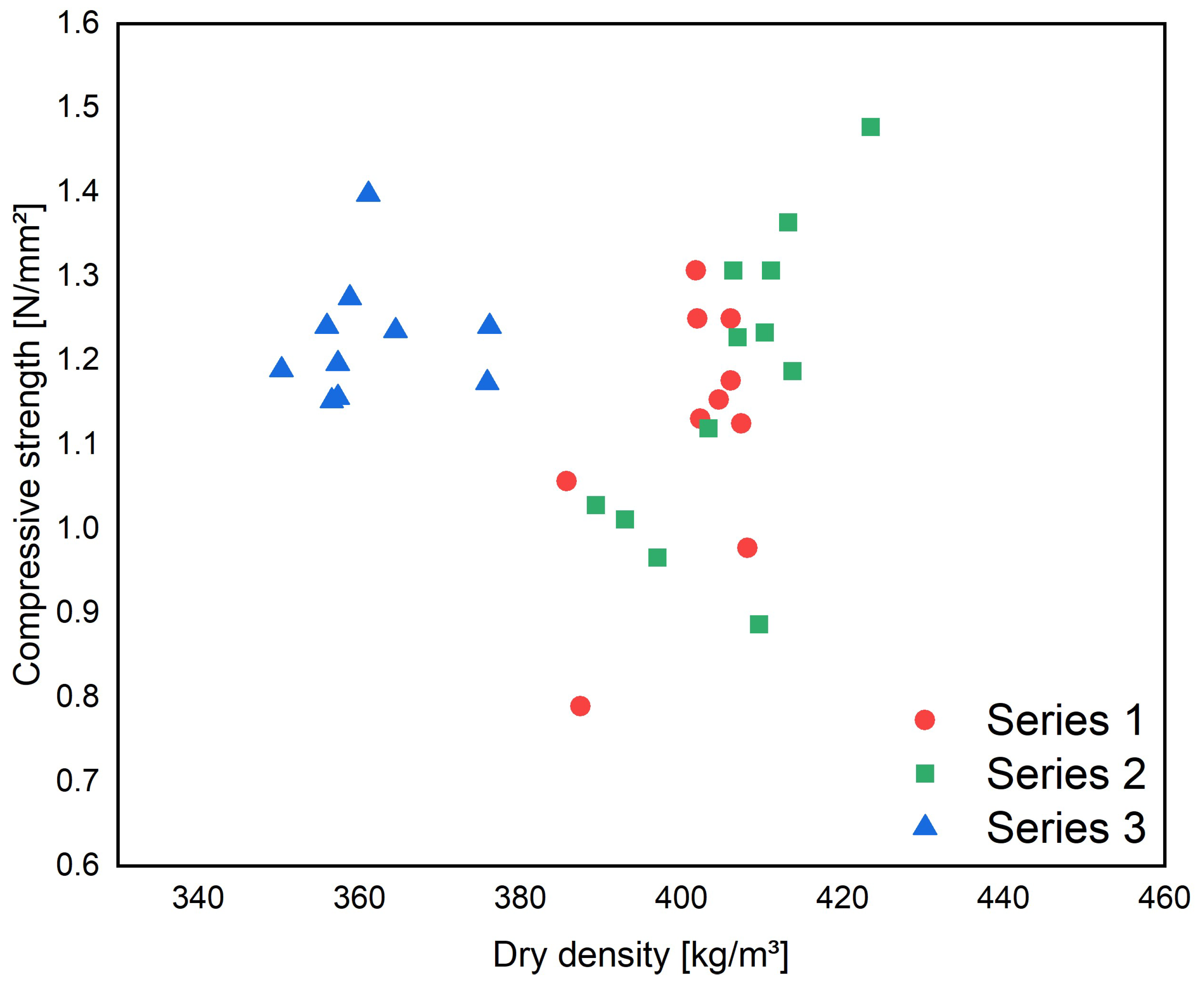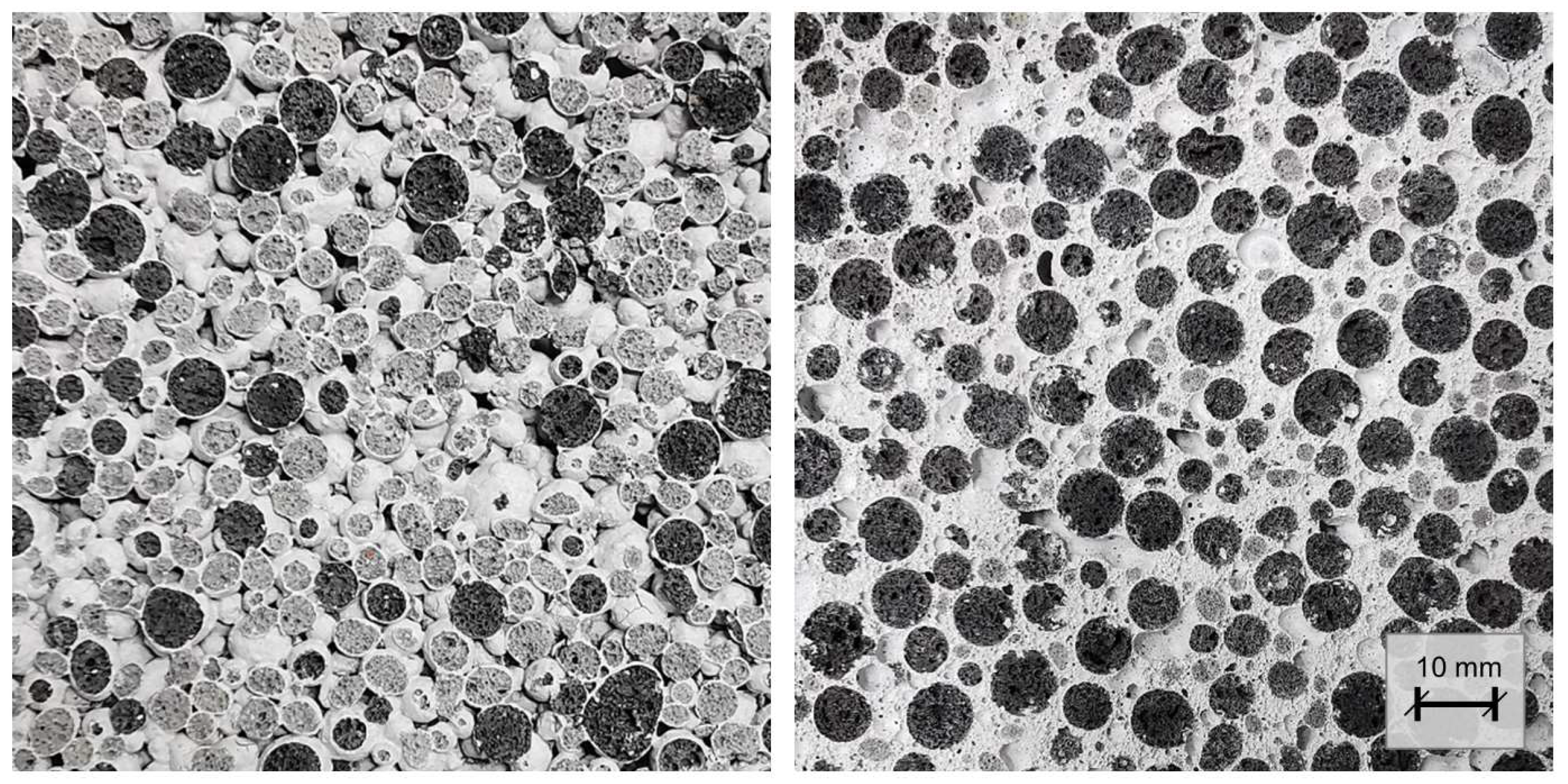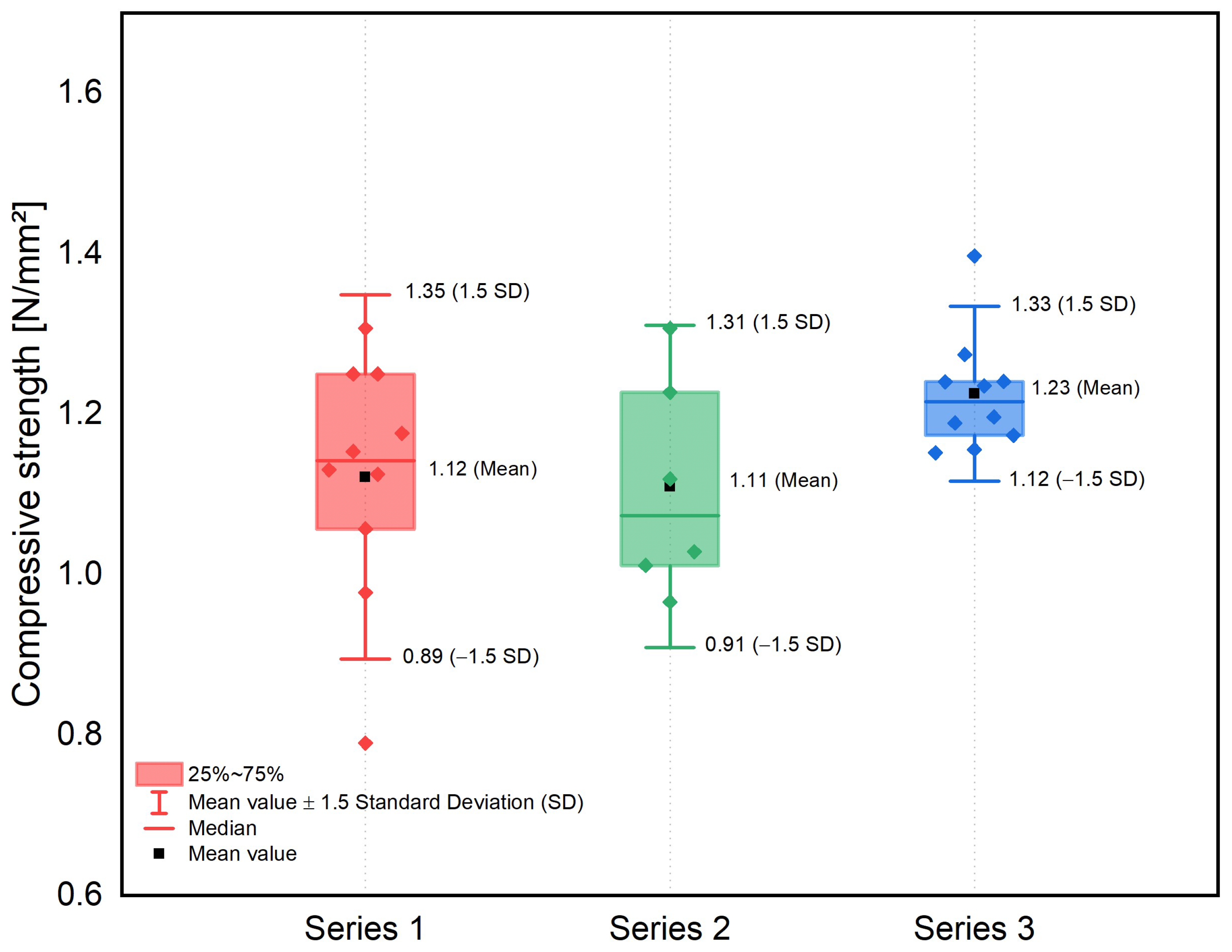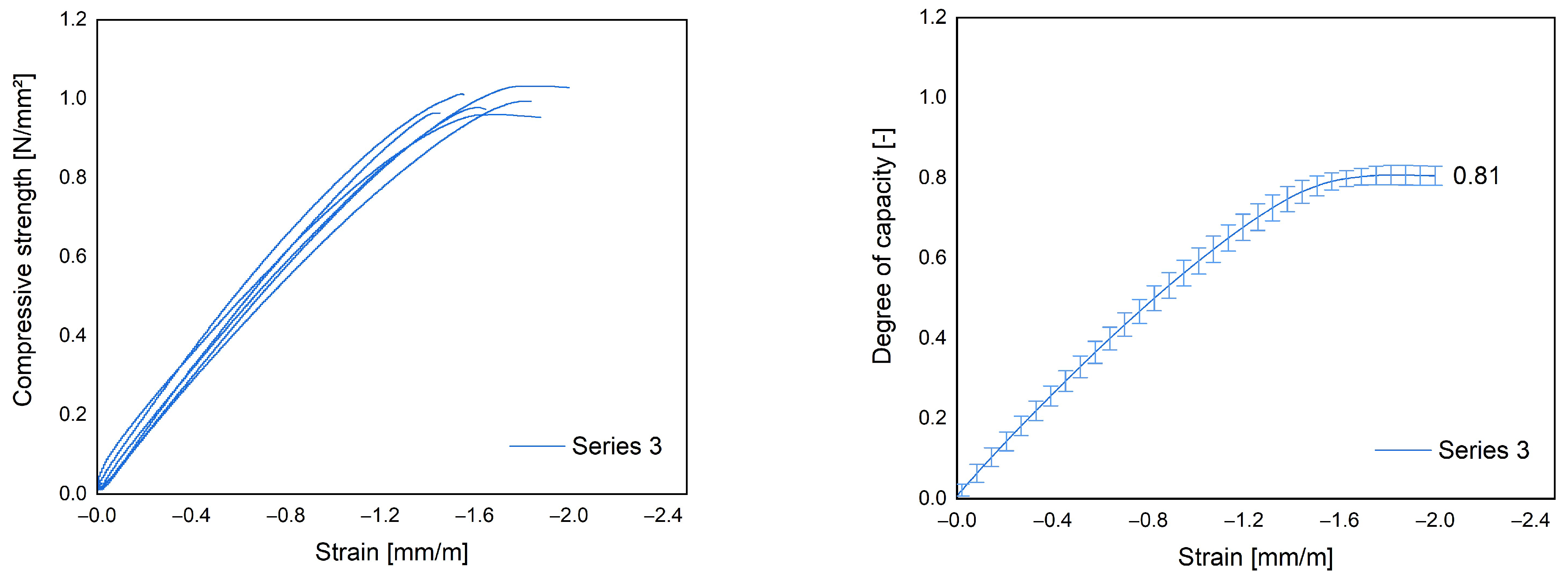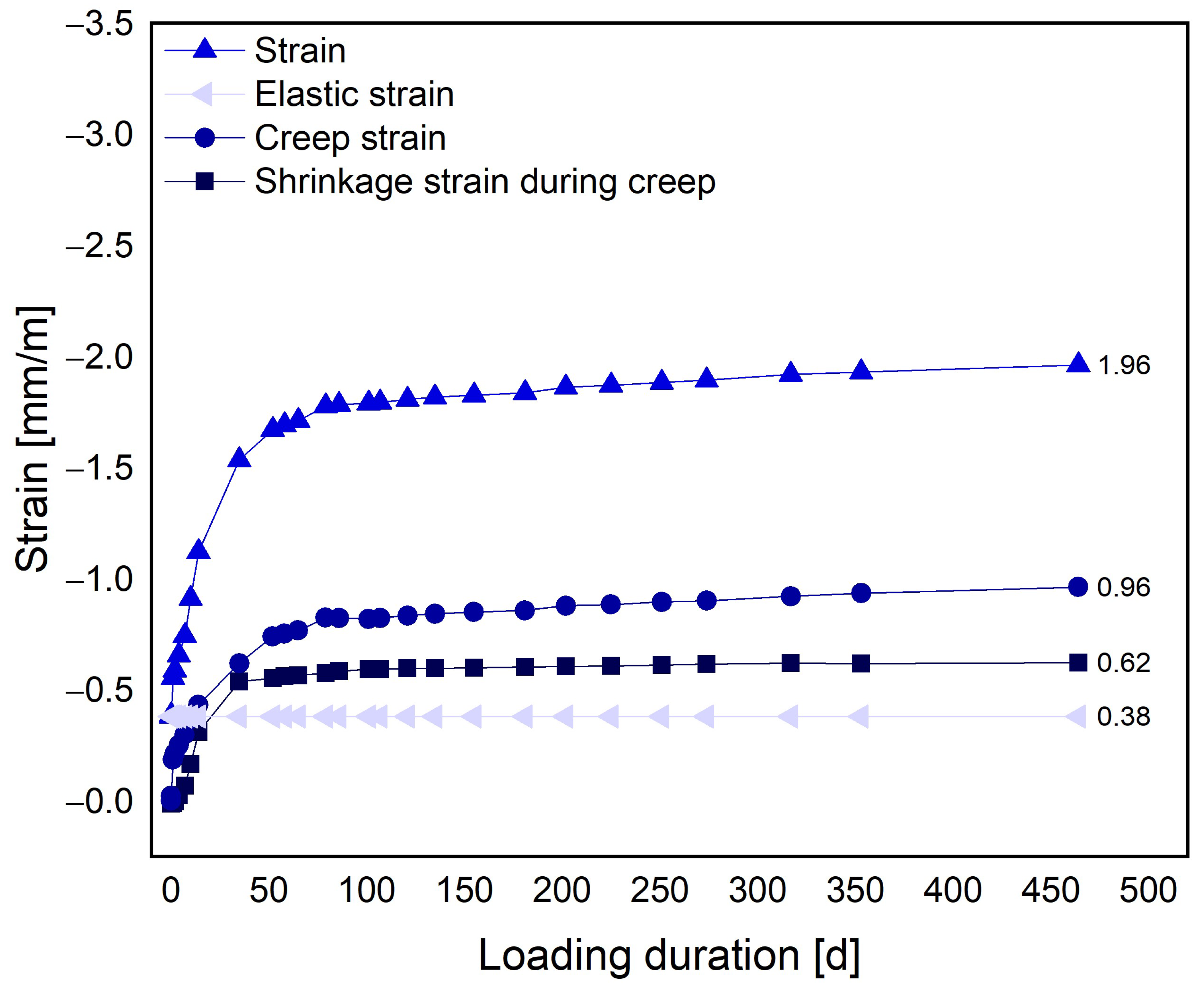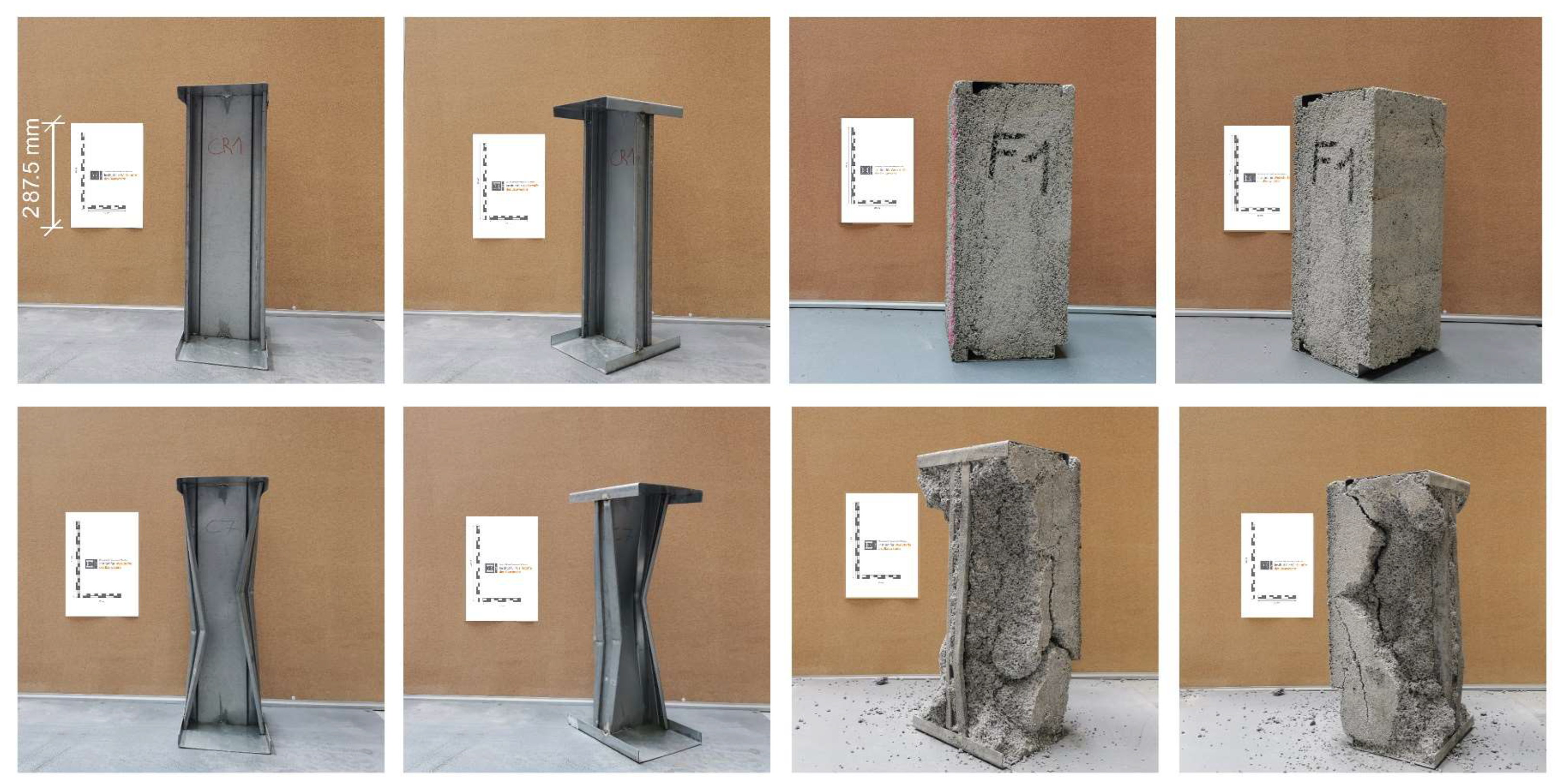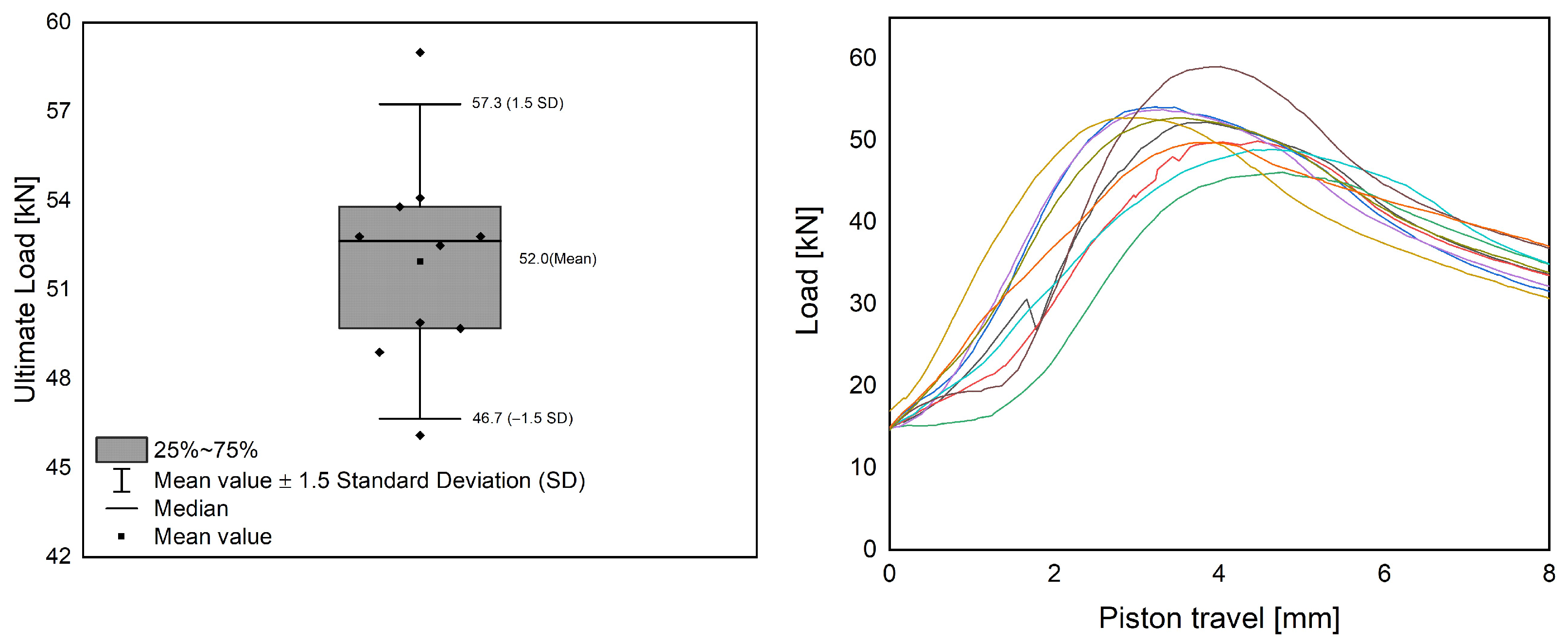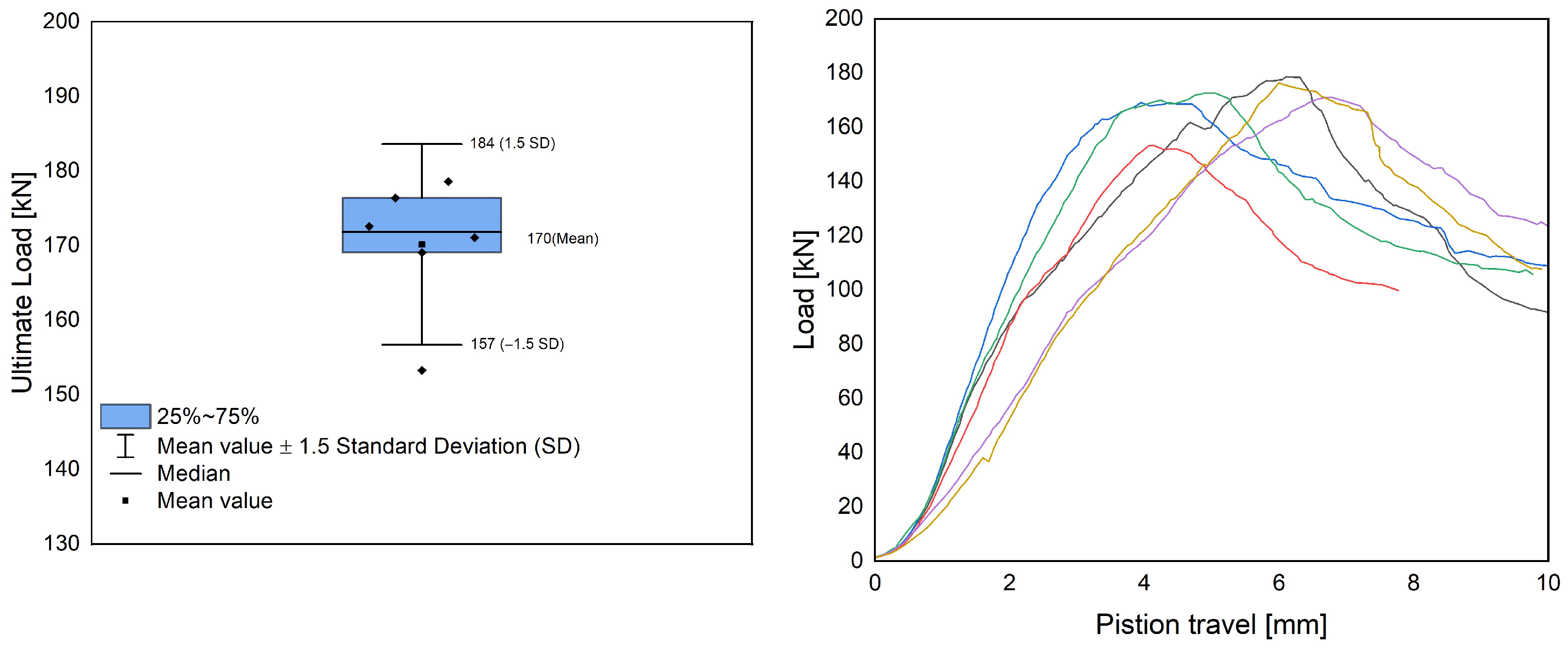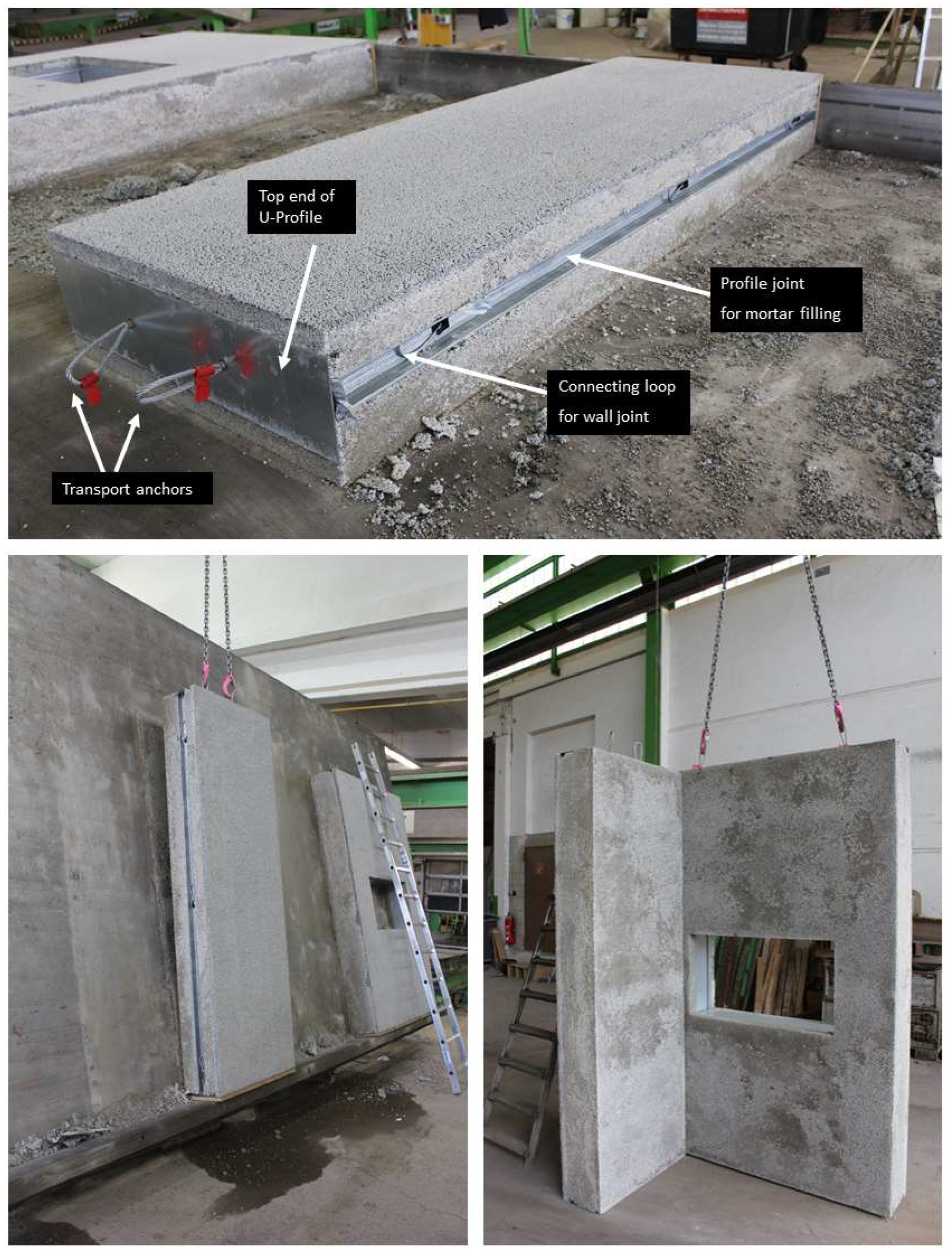1. Introduction
Concrete and steel are the most important structural building materials, which define our built environment in a variety of design forms and therefore shape our modern social lives. Intensive efforts are being made to develop new construction methods to meet increasing ecologically and economically sensitive demands. Therefore, a new prefabricated construction method for wall elements has been developed. The wall element consists of a framework made of thin-walled sheet steel profiles, which is integrated into a heat-insulating lightweight concrete building envelope. The elements can be produced in a precast concrete plant and assembled on site.
Figure 1 shows a schematic representation of the new construction method.
The wall element’s primary load-bearing function is accomplished by cold-formed steel profiles. These profiles are vertically aligned in a row with defined spacing and connected at the bottom and top by spot welding to non-load-bearing U-channels. The steel profiles form a framework taking into account the subsequent wall design (e.g., technical installations, window openings, and connection elements) before being placed on the molds for concreting. The concreting is carried out with an optimized lightweight aggregate concrete (LAC). The connection of wall elements can be accomplished by means of the profile joints with mortar filling and additional mechanical joints, which are common in prefabricated construction.
The LAC developed within the scope of this work has a dry density of less than 400 kg/m
3 and a corresponding low strength. Both are clearly below the normative limits of EN 1520 [
1], but the new LAC still exhibits a great similarity in terms of material technology. For the purpose of clear differentiation, the LAC developed in the course of this work will be referred to as LAC+ in the following sections.
This new approach is designed to utilize LAC+ for its low-density characteristics, which directly influence thermal conductivity. This yields a highly competitive material in terms of energy efficiency, aligning it with increasingly stringent energy-saving regulations in the construction sector. However, as the density decreases, the compressive strength of the LAC+ also decreases. Due to its low compressive strength of around 1 N/mm
2, the LAC+ is unsuitable for traditional load-bearing applications. At this critical point, the sheet steel framework comes into play. It provides the necessary load-bearing capacity of the building envelope, which in turn allows for an intended significant reduction in the required compressive strength of the LAC+. The sheet steel profiles are designed to efficiently utilize the material, resulting in slender profiles, which minimizes their impact on thermal conductivity. When the profiles have significant length (e.g., equal to the wall height), their failure is more likely to occur due to stability issues rather than material failure. In traditional steel construction, lateral bracing, such as cross-bracing, diagonal bracing, or shear walls, can be employed to prevent lateral deflection and ensure stability. In this case, the LAC+ provides this lateral bracing by surrounding the steel profiles and effectively preventing buckling (stability failure), ensuring that the steel profiles offer sufficient load-bearing capacity. This allows us to reduce significantly the required compressive strength of the LAC+ and opens the chance to lower the densities to such an extent that competitive thermal conductivity values unseen for LAC thus far can be achieved for meeting today’s energy requirements. The resulting connection between LAC+ and the steel framework must endure, even in the presence of time-dependent deformations, such as shrinkage and creep, or when subjected to sustained loading. This resilience is critical because damage resulting from this deformation has the potential not only to significantly reduce structural stiffness and strength but also to accelerate framework corrosion, thereby significantly impacting the overall durability [
2]. The underlying fundamental concept of load transfer and construction methodology is well established for drywall systems, where a metallic framework serves as the primary mechanism for load distribution, while gypsum or wooden oriented strand boards stabilize the framework.
This approach is in line with the increasing stringency of energy saving regulations in the construction sector, which are putting significant pressure on manufacturers of exterior concrete wall elements. These regulations require the achievement of minimum thermal conductivity in order to produce competitive elements for exterior walls. Such requirements have pushed the application of the material to the limits of its intended use under regulatory conditions. Against this background, the new prefabricated construction method is intended to offer an alternative to satisfy the high market demand for low-cost, fast-to-build, and durable buildings. The low thermal conductivity of the building envelope made of optimized LAC allows for meeting such demands. It is a sustainable solution since it can be separated and recycled easily and completely due to its clear materiality. The new construction method is an innovative solution that optimizes the use of lightweight concrete and steel and combines them in a sustainable way. The benefits of this new wall element design include high thermal insulation, fire resistance, sound insulation, durability, and flexibility. The wall element can be customized to meet different architectural requirements and aesthetic preferences. The prefabrication process reduces labor costs and on-site errors, shortens construction time, and improves safety. The new construction method is suitable for use in multi-story residential buildings as well as industrial or commercial buildings. The construction system could also be used for adding additional floors to buildings. Similar to the currently common construction designs, the low weight ensures comparatively low dead loads of the slabs.
1.1. Background Information on Lightweight Aggregate Concrete (LAC)
The utilization of stationary production methods for concrete components facilitates the standardization and mass production of prefabricated elements, thereby playing a critical role in the industrialization of the construction process [
3,
4,
5]. The development of standardized elements goes along with the steadily advancing rationalization of the construction process and promises competitive advantages over cast in place concrete construction due to shorter construction times, reduced labor costs, weather-independent production, and high quality assurance [
3,
4,
5]. Typical applications of the precast construction method in building construction include industrial buildings and warehouses, parking garages, office buildings, hospitals, schools, and multistory residential buildings [
3,
4,
5]. In structural engineering, precast elements are used in particular when a significant cost advantage can be expected or when the construction conditions at the site cannot be achieved otherwise at a justifiable cost [
4]. This applies, for example, to the manufacture of bridges, towers, or masts. Other important product areas include elements for water and wastewater management (e.g., tanks, pipelines, or sewage systems), and elements for traffic infrastructures (e.g., railroad ties, noise barriers, or modular paving) [
3,
4,
5].
In the course of the 1990s, national standards and regulations were technically revised so that the use of lightweight concrete was standardized on an equal level with normal concrete [
6]. Structural lightweight concrete (LC) suitable for reinforced concrete with a closed structure is regulated in EN 1992-1-1 [
7] and EN 206 [
8]. In addition, lightweight aggregate concrete (LAC) with an open structure for prefabricated reinforced components is covered by EN 1520 [
1]. LAC is characterized by voids between aggregates formed by the omission or reduction of individual grain sizes that remain in the structure after compaction. The volume of the cement paste is reduced to such a degree that the aggregates are just pointwise interconnected [
9,
10]. LAC is produced almost exclusively with coarse lightweight aggregates, which is why the term no-fines is also used synonymously, although low-fines would be more suitable [
10]. From the point of view of concrete technology, the structure of the LAC thus differs significantly from that of the dense structural LC. LAC is used to produce wall blocks and load-bearing and insulating wall elements, as well as non-structural components such as noise barriers or drainage concretes [
11]. A new market segment opened for LAC wall elements due to the concrete technology available today (e.g., concrete admixtures and agents, as well as the continuous development of manufacturing processes and machine technology), along with the availability of lightweight aggregates (LWA) with particularly low density (e.g., expanded glass). This development allowed for low-density exterior walls to achieve thermal conductivity without the need for additional insulation.
1.2. Research Significance
Despite the widespread use of LAC in various construction applications, the innovative approach lies in its integration with the steel framework to create an energy efficient building envelope. The building envelope requires no additional insulation materials and provides thermal performance that is at least competitive with traditional envelope systems. This unique combination addresses key challenges in the construction industry to reduce energy consumption and improve building performance. This research gap highlights the need to evaluate the potential and suitability of this approach. This study will address the following three key research questions:
Feasibility of manufacturing an optimized LAC below the normative limits: A key challenge for manufacturers of precast monolithic walls is to achieve significantly lower thermal conductivity than conventional construction techniques, due to more stringent thermal insulation requirements. The purpose of this question is therefore to examine the feasibility of using a LAC+ with the greatest possible reduction in density and subsequent thermal conductivity while maintaining sufficient strength as a component in a new prefabricated wall system.
Assessing the robustness of LAC+ stability across varied conditions: The stability of the LAC+ must be maintained even during time-dependent deformations (e.g., shrinkage and creep) or under continuous loading. In addition, the compatibility of the LAC+ with the conventional compaction techniques used in the precast industry (roller compaction and/or vibratory compaction) should be verified, taking into account the change in consistency caused by the foam and the obstacles created by the steel profiles. This assessment is essential to ensure the quality and structural integrity of the precast elements even under full-scale conditions.
LAC+ as structural reinforcement: In this study, LAC+ acts as a critical element in the structural reinforcement, providing lateral bracing to the steel framework. By encasing the steel profiles, LAC+ provides stability and effectively prevents buckling of the integrated steel framework. As a result, a novel testing methodology is used to assess the overall strength and stability of the structure.
To address these research questions, a comprehensive approach was taken. Given the novelty of the LAC+ material technology at the anticipated low density, no previous studies have examined its fundamental material characteristics. Consequently, extrapolating existing standards becomes uncertain. Hence, an experimental investigation was conducted to evaluate the characteristic properties of LAC+. Therefore, three real-scale batches were produced in two precast plants as full-scale trials. Additionally, representative composite specimens were utilized at a smaller scale to demonstrate the capacity of LAC+ in stabilizing the load-bearing sheet steel profiles. Furthermore, prototypes were manufactured as a proof of concept of the potential and suitability of this approach for practical applications. These prototypes consist of full-size wall sections with connection details such as exterior wall joint, transport anchors, and a window opening. The prototypes were manufactured in both partners’ precast plants to ensure consistency and reliability.
By implementing this comprehensive approach, this study provides empirical data, practical validation, and prototypes that collectively support the potential application of the new construction method for building envelopes and defines a practical testing methodology to address the unique challenges.
3. Results and Discussion
3.1. Hardened Concrete Properties
In general, the optimum compromise between density, strength, and thermal conductivity is at the forefront of LAC+ mix design. Based on the preliminary laboratory tests, the desired material properties are achieved through the systematic use of chemical additives and admixtures, together with adjustments to the material composition and manufacturing process. As the complexity and performance of the material increases, so does the sensitivity of the material’s behavior. The type and content of the cement and aggregates, the characteristics of the cementitious foam, the type and concentration of the additives and admixtures, and the timing of their addition have been identified as the main influencing factors. Based on results of initial trials, three larger test series were produced in the precast plants.
Table 5 provides the parameters of the LAC+ for the test series produced in the two precast plants.
Figure 3 illustrates the relationship between the compressive strength and dry density of the three test series.
The dry densities achieved were around 400 kg/m3 for the first two test series. The scatter of strength values was significant, reflecting the challenges faced by the precast plants mentioned earlier. By further optimizing the manufacturing process, the dry density was reduced to 360 kg/m3 in test Series 3. The variations in dry density are relatively small for all series. The difference between the heaviest and lightest sample is 34, 58, and 22 kg/m3 for Series 1, 2, and 3, respectively. This fact indicates that the mix design can produce homogeneous and stable concrete even on a factory scale. This was accomplished for the strength values in Series 3 as well. Based on the preliminary laboratory tests, this was initially one of the major uncertainties in mix design.
This uncertainty is due, on the one hand, to the specific nature of the LAC mix design and, on the other hand, to the degree of porosification of the paste between the LWA. With regard to the specific nature of LAC, it should be noted that the optimum water/binder ratio is only within a narrow range. Depending on the chosen LWA composition, a too high water to binder ratio will result in the cement paste draining from the surface of the LWA during compaction, while a too low water to binder ratio may result in adhesive agglomeration of the LWA [
9]. With regard to the porosification of the paste between the LWA, it is essential that the foam maintains its quality and quantity in a stable manner. The additives used to produce the foam are usually very sensitive to variations in dosage, temperature, and mixing time. This becomes obvious, for example, in the pore structure of the artificial air pores. Other studies have shown that as the density of the foam decreases and mixing time increases, larger pore diameters are formed which tend to collapse during compaction [
10] or result in reduced compressive strength of the hardened concrete [
34]. Another special consideration when porosifying the paste is that only the voids between the LWA are filled. While too little foam will only result in inadequate filling of the voids between the LWA, too much foam would cause the LWA to simply float in the foam, and the load transfer along the LWA, which is characteristic of LAC, would no longer be ensured. This effect can be seen in
Figure 4. While the left cross-section shows only partial porosification of the matrix (structure very close to conventional no-fines LAC), the right cross-section shows a correct and complete porosification of the paste filling the voids between the LWA.
This fine tuning of the porosification determines the density, which is directly linked to the thermal conductivity, as well as the compressive strength of the LAC+, and thus the structural design of the components. In this context, a significant goal of the optimization of the LAC+ is achieving the lowest possible density and thus thermal conductivity. However, a reduction in these parameters is accompanied by a reduction in compressive strength. Further, the strength of the LAC+ must be sufficient to adequately stabilize the steel sections of the structure. A detailed overview of the compressive strength achieved for the optimized test series produced in the precast plants can be found in
Figure 5.
The test results yield a compressive strength of the LAC+ of approx. 1.1 N/mm
2. Furthermore, the statistical indicators for the quality control of concrete production were found to lie within the usual scatter range for LAC and confirm the previously formulated assumption of successful adjustment of the porosification of the paste between the aggregates. Series 3 exhibits a slightly higher compressive strength although its dry density is approximately 40 kg/m
3 lower than the other series. Series 3 is an improvement of Series 1 and the higher compressive strength is probably due to a better match between foam and fresh concrete in the mix design (cf.
Figure 5) and training of the personnel involved in the precast plant.
The porosification and volume of the hardened cement paste also affect the modulus of elasticity. According to the standard (DIN EN 1520 [
1]), the modulus of elasticity can be estimated empirically from the dry density and characteristic compressive strength. For the present test series 1, 2, and 3, the estimated moduli of elasticity are 1016 N/mm
2, 1106 N/mm
2, and 1240 N/mm
2, respectively. The experimentally determined moduli of elasticity (cf.
Table 3) are consistently lower than the estimated values. This discrepancy can be attributed, in part, to the porosity of the hardened cement paste, as the reduced stiffness of the cement paste can lead to decreased resistance to deformation. It is important to consider the significant variability in the stiffness of different LWAs as well. In this context, it should be noted that the normative and empirical determination of the modulus of elasticity applies to all LWA approved by this standard. Therefore, the estimation reflects an average relationship and does not account for the specific characteristics of individual LWAs.
3.2. Compressive Strength Capacity under Sustained Loading
Strength under sustained compressive loading is an important parameter for the design and performance of LAC+. It reflects the ability of the material to resist deformation and prevent cracking under long-term service conditions. In general, the compressive strength capacity under sustained loading can be understood as an elementary microstructural threshold above which irreversible and unstable damage progression must be expected. For safe material utilization and saving of resources, a realistic coefficient for long-term effects on compressive strength must therefore be determined for the LAC+.
Figure 6 illustrates the variation in mean relative load capacity, defined as the ratio of the sustained compressive strength to the average compressive strength at 28 days, with respect to longitudinal deformations. The corresponding individual stress–strain curves are provided individually on the left.
The experimentally determined threshold for sustained loading is 81% for test series 3. This value is comparable to the known α
cc for long-term effects on compressive strength for lightweight concrete (according to Eurocode 2: 85% [
7], cf.
Section 2.2.4) and the one for LAC (85%) according to the DIN EN 1520 [
1]. The normative and generalized determination of the reduction factor α
cc would overestimate the long-term performance of LAC+. This is confirmed by research conducted by Empelmann [
35], who concluded that α
cc does not always provide conservative results. Furthermore, the relationship between longitudinal deformation and applied stress is very similar in the lower stress range and only deviates more strongly at higher compressive stresses. This behavior is known from concretes and speaks for a homogeneous load transfer of the optimized LAC+.
3.3. Shrinkage and Creep of the LAC+
Time-dependent deformations can occur due to load-independent processes such as shrinkage or load-dependent processes such as creep [
36]. Minimizing the deformations of the LAC+ is essential to minimize cracking, to restrain stresses, and to ensure a permanent bond between the LAC+ and the steel framework. Unlike normal concrete, the time-dependent deformations of LAC+ are largely determined by the aggregate used, although they do not show time-dependent behavior themselves [
37]. The main influencing parameters of the LWA are their low density and the associated modulus of elasticity as well as their porosity and stage of water saturation. There is not a wide range of published empirical values for the deformation properties of LAC with a porosified matrix, especially for the present density ranges. Thienel [
10] found that the shrinkage values of a LAC without fines and a properly manufactured LAC with a porosified matrix are similar, and at a density of 600 kg/m
3 are approximately 0.6 mm/m. Thienel [
10] also observed that a LAC with a porous matrix exhibited higher specific creep values as compared to a conventional LAC. However, the risk of shrinkage cracking was reduced due to the high relaxation potential of the LAC. DIN EN 1520 [
1] suggests using 0.75 mm/m for drying shrinkage in an environment with 45 ± 5% rel. humidity.
Figure 7 shows the shrinkage and creep deformation curves for test Series 2 over time.
The shrinkage deformation curves in
Figure 7 are comparable with normal LAC. The results determined within the scope of the present tests are thus within the expected results. However, it must be noted in this comparison that the age of removal differs from the one set in [
38]. In relation to the residual stress resulting from shrinkage deformation in precast concrete elements, it should also be noted that a significant portion of the deformation can be alleviated during the curing process in the precast plant and thus before installation on site.
3.4. Trials on Composite Specimens
The composite specimens consist of a sheet steel framework embedded in the LAC+. The successful integration of the sheet steel framework into the LAC+ is critical to the overall development of the wall component. The framework of sheet steel profiles fulfils the load-bearing tasks of the component in the wall. The surrounding LAC+ prevents buckling of the steel profiles and thus yields sufficient load-bearing capacity. As there are no standardized test procedures for this new precast construction method, an individual test program was developed for the composite components (cf. Chapter 2.3). For this purpose, the load-bearing behavior of a plain steel profile is compared with that of an identical steel profile embedded in the LAC+.
Figure 8 shows the specimens in comparison. The left half shows the plain steel profile, while the right half shows the composite specimen. The buckling failure of the plain steel frame is obvious. In contrast, the embedded steel frame exhibits no such deformation. Here, the failure was caused by spalling of the LAC+ which subsequently destabilized the steel frame and led to failure. The upper half of the photos shows the specimens before the test, while the lower half shows the specimens after the test.
In
Figure 9, the results of the compression tests are summarized for the plain steel frames in a Box–Whisker diagram on the left side, while the corresponding load-displacement diagrams are shown on the right side.
The results of the compression tests on the sheet steel profiles confirm that the designed specimen type is suitable for the chosen test setup. The results in the compression test are reproducible and show only minor deviations from the mean value. The average ultimate load of the plain steel profiles is 52 kN and thus well below the value that can theoretically be achieved by material failure. Otherwise, buckling values of around 110 kN would have been expected (cf.
Table 1). Thus, the test setup successfully triggers a stability failure of the profile.
Figure 10 exhibits the results of the compression tests for the composite specimens.
The results of the experimental investigation show that the use of LAC+ as an embedding material for steel sheet profiles can significantly improve their load-bearing capacity. The composite specimens exhibited an ultimate load of 170 kN, which is more than three times that of the plain steel sheet profile (52 kN) and more than 50% higher than the maximum compressive load capacity specified by the manufacturer (110 kN, cf.
Table 1). This indicates that the bond between the sheet steel profile and the LAC+ was effective in transferring the load from the sheet steel profile to the concrete section and preventing stability failure due to buckling. However, it should be noted that these results are based on a limited data set and do not allow for generalization or the derivation of design formulae to calculate the compressive capacity of composite specimens with different concrete qualities, profile geometries and types, and concrete coverings. Further research is needed to investigate these variables and to extend the test program to include strength tests on mock-up walls, which would better reflect the actual behavior of composite elements in structural applications. A possible reference for such a test program could be DIN EN 1520 Annex B (design of components based on tests) [
1] or ASTM E72 [
39], which provides standard methods for conducting strength tests on structural panels.
3.5. Implementing Laboratory Findings in Production: Demonstrator
In general, there are significant challenges in ensuring the applicability of laboratory tests to full-scale production in manufacturering plants. One notable difference is the controlled environment of laboratories, with optimum humidity and temperature conditions, and calibrated and more precisely controllable instruments (e.g., mixing energy and time). However, when testing on a larger scale, such as in production plants, there are unique considerations for lightweight concrete. These may include the need for specialized equipment, such as foam generators, to accommodate complex mix designs. In addition, factors such as saturation of LWA, which can be controlled precisely in the laboratory, need to be taken into account, whereas in concrete plants with open storage and weathering, greater variations are to be expected. In addition, the development of heat of hydration becomes more of an issue with larger samples, such as wall elements, where heat dissipation is less efficient compared to smaller laboratory samples.
In the context of the research presented, there are also a number of considerations that need to be taken into account when handling the samples, given the exceptionally low strength of the concrete. The performance of a structural component is influenced by various factors, including the composite effect between the LAC+ and the steel framework. However, the transfer of shear forces, as well as the introduction of local compressive and tensile forces, are crucial for the overall performance of the component. To introduce these local loads into the construction system, connection and anchorage elements are used. During the transportation, lifting, and assemblage of individual precast elements, there is a risk of introducing large and variable loads into the component. Hence, careful consideration must be given to the design and implementation of these elements to ensure the safe and efficient functioning of the component. The implementation and handling of the adapted connecting elements was tested exemplarily on the prototypes.
Figure 11 gives an impression.
The feasibility of the proposed new construction method, through the successful translation of laboratory findings into production, offers an efficient use of building materials with improved energy efficiency in the building environment, striving towards sustainable building practices. As a result, the proposed building envelope does not require additional insulation materials and provides thermal performance that is at least competitive with traditional envelope systems.
4. Conclusions
This study aimed at presenting a novel construction method for prefabricated wall elements, in which a filigree steel framework takes over the load-bearing function, and a tailor-made LAC provides thermal insulation and stability. To accomplish this, the properties of LAC were optimized, with the objective of achieving the lowest possible density and thermal conductivity while maintaining sufficient strength to prevent framework stability failure. The optimized LAC+ was intended to create a building envelope that complies with current energy regulations without requiring additional insulation. The successful development of the novel construction method was validated in cooperation with two precast plants, demonstrating the transfer of laboratory findings to the real scale. The main findings can be summarized as follows:
The mechanical properties of the potential LAC+ candidates were fundamentally characterized on the basis of three extensive real-scale batches. A notable result of this characterization was the remarkable reduction in compressive strength to as low as 1.1 N/mm2. This reduction in compressive strength created a pathway for density reduction, ultimately achieving densities as low as 360 kg/m3. This in turn led to the achievement of competitive thermal conductivity values as low as 0.09 W/(m∙K). The porosification of the matrix between the LWA grains plays a special role in the successful transition from laboratory to real scale.
Short-term tests with a low loading rate revealed a reduction coefficient of 0.81 to account for the reduced compressive strength of the LAC+ under sustained loading. This result is comparable to the factor 0.85 proposed for LAC in DIN EN 1520 [
1].
Composite specimens, which represent a wall section with a vertical sheet steel profile embedded in the LAC+, were tested to demonstrate the ability of the LAC+ to stabilize thin-walled sections against buckling. The mechanical performance of the framework was significantly increased with the use of LAC+.
Based on the obtained mechanical properties of the LAC+ and the composite tests, two prototypes were produced in precast plants of project partners. The design of the prototypes represents wall sections in original size and takes into account a connection detail (outer wall joint) and anchors (transport anchors), as well as a window opening. The experimental tests have thus been successfully transferred to the real scale.
For developing a comprehensive design concept for wall elements, it is necessary to conduct further tests that consider various profile types and cross-section geometries. Additionally, it is important to perform tests with various concrete covers and on the effective cross-section of the LAC+ within the wall element. These tests will provide insights into the behavior of the proposed construction method under different conditions and will support the development of an optimized design approach that meets the required performance criteria.

